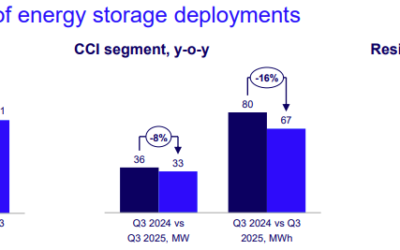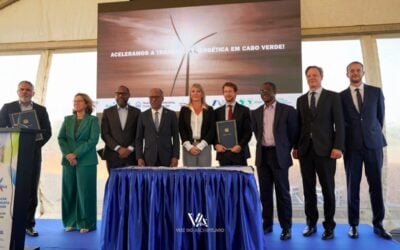Ontario IESO president and CEO Bruce Campbell officially switches on the project. Image: Powerstream.
What is thought to be Canada’s first virtual power plant (VPP), aggregating the capabilities of a small fleet of solar PV-plus-storage systems with energy management software, has been deployed in Ontario.
Powerstream, a “community-owned” energy service provider with close to 400,000 customers, has installed the systems at 20 households in what has been described as a showcase of what the technology can do.
For the homeowners, the behind-the-meter lithium battery systems will allow them to time-shift their stored solar power. The province’s electricity markets apply time-of-use pricing to a majority of customers. According to the Ontario Energy Board, off-peak prices were 8.3 Canadian cents (US$0.063) per kilowatt hour, peak at 17.5 cents per kilowatt hour, with a mid-peak price of 12.8 cents per kilowatt hour, as of November 2015.
The systems will also provide some backup power capabilities, in the event of outages. Just this morning, Powerstream’s twitter account reported “major outages” in the city of Vaughan, within its service area.
Try Premium for just $1
- Full premium access for the first month at only $1
- Converts to an annual rate after 30 days unless cancelled
- Cancel anytime during the trial period
Premium Benefits
- Expert industry analysis and interviews
- Digital access to PV Tech Power journal
- Exclusive event discounts
Or get the full Premium subscription right away
Or continue reading this article for free
From the network’s point of view, the use of these resources in reducing peak loads on the system, regulate frequency and defer capital investment costs in infrastructure. Powerstream’s pilot has received funding from the Ontario Independent Electric System Operator (IESO), the organisation charged with maintaining the grid.
“Powerstream’s Virtual Power Plant is one example of a new solution that we expect to have significant potential in Ontario,” Ontario IESO’s president and CEO, Bruce Campbell, said. Each participant in the pilot will receive a 12kWh battery, a solar array and a bi-directional meter. Powerstream said it partnered with solar-integration storage system provider Sunverge on the project, as well as electrical contractor Robertson Bright.
Ontario’s long-term goals for energy
Powerstream’s board chairman Maurizio Bevilacqua, who is also the mayor of Vaughan, said the idea was one of a number that could have significant potential for Ontario.
Rob Harvey of Ontario Energy Storage, a trade group with over 35 member companies, recently told Energy Storage News that the provincial and national government’s outlook on energy combined a long-term approach with an emphasis on carbon reduction, energy security and affordability.
While it is a concept in its infancy, according to most definitions, ‘virtual power plant’ usually refers to the use of aggregated distributed resources to replace the function of conventional power plants, such as gas turbine ‘peaker’ plants or coal, which often run throughout the day and night to ensure their capacity is available to balance the grid when necessary. Large-scale batteries can replace a portion of this function, needing only a few minutes, seconds or even microseconds to respond to grid signals and inject power into the network.
Other regions of the world have started trialling the use of VPPs and other forms of aggregated behind-the-meter storage systems. While most are at the pilot stage, there are already grid-connected networks of this kind in Germany, Britain, the US and Australia, where Sunverge has been involved in a number of trials.
Many industry figures have said the idea is still at an early stage and will require significant scale before the potential can be reached – for instance, in Germany, aggregated resources must amass a couple of megawatts in size before being allowed to enter the frequency regulation market. However, the potential for VPPs and similar concepts, such as community energy trading platforms where customers could share their stored surplus power, or ‘software-defined power plants’ which combine a number of different distributed resources including solar, batteries and CHP, continue to be explored.
In a recent report, analysis firm Navigant said it expected virtual power plants to have a massive impact on the energy space in the coming years.





